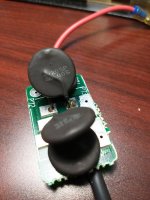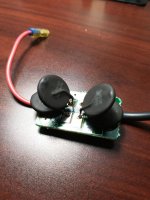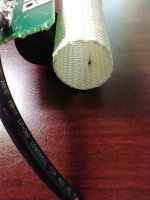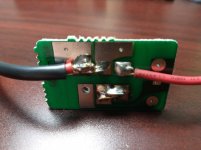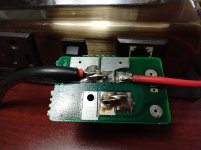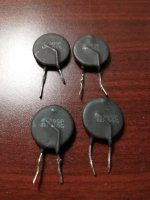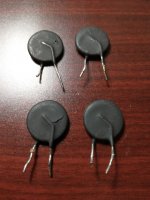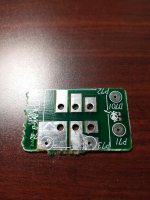I am trying to troubleshoot my Parasound amplifier that keeps blowing the main 15amp fuse shortly after power is applied.
I "think" I have traced the problem to this board: When I turn on the amp, I hear a slight sizzle/crackle sound. One time I turned it on and a small amount of smoke came from this board. Note the brown spot on the insulating jacket.
This board runs between the power plug, the main fuse and the power switch. The amp is almost 30 years old so likely this board and components are that old as well.
Can anyone identify this? Are the components in fact MOVs? They do have some bulging spots and on one of them the black insulating cover has come loose.
Will this Littelfuse serve as a viable replacement?
Thanks.
I "think" I have traced the problem to this board: When I turn on the amp, I hear a slight sizzle/crackle sound. One time I turned it on and a small amount of smoke came from this board. Note the brown spot on the insulating jacket.
This board runs between the power plug, the main fuse and the power switch. The amp is almost 30 years old so likely this board and components are that old as well.
Can anyone identify this? Are the components in fact MOVs? They do have some bulging spots and on one of them the black insulating cover has come loose.
Will this Littelfuse serve as a viable replacement?
Thanks.
Attachments
I assume you are on 115 volt mains. Always worth checking it is not high.
How are they wired together, for example are they all in parallel and then across L and N?
Hmmm... visually its hard to say, there are plenty of high voltage ceramic caps that look just like those from a physical perspective.
How are they wired together, for example are they all in parallel and then across L and N?
Are the components in fact MOVs?
Hmmm... visually its hard to say, there are plenty of high voltage ceramic caps that look just like those from a physical perspective.
I assume you are on 115 volt mains. Always worth checking it is not high.
How are they wired together, for example are they all in parallel and then across L and N?
Yes, 110-120 volts.
The red (hot) lead from the power input at the back goes to the 15amp main fuse and then from the fuse it goes to this small board and from this board it goes to the power switch. The neutral wire goes from the power input at the back to the power switch.
After the power switch, the power appears to go to the toroidal transformer.
I have only had this amp a few months but when I first installed it, it wouldn't power on occasionally when using the power switch. I thought the power switch was bad so I left it in the ON position and used my power conditioner to power it up. It worked fine this way for several months. I had it out of my rack for another reason and when I put it back in it blew the fuse. To test the power switch, I bypassed it so it isn't the power switch. The only other components on this leg of the circuit are this board, the fuse and the power port. Since smoke was coming from this board I am assuming this may have finally failed?
Thanks.
MOV's (or caps) are wired across the supply and what you seem to describe is not that.
Have you measured them on an ohmmeter? Could they be thermistors for inrush current protection?
Have you measured them on an ohmmeter? Could they be thermistors for inrush current protection?
I haven't removed them from the board yet to test them - I will do that tomorrow AM.MOV's (or caps) are wired across the supply and what you seem to describe is not that.
Have you measured them on an ohmmeter? Could they be thermistors for inrush current protection?
If this is a thermistor, do these things just go bad over time?
I think so to from how it seems wired. Suppression (MOV's, caps) would also not normally be a on a board with flying leads.It looks like a NTC thermistor,
Yes, that is the correct flow.This is how I visualise it based on what you say. If that board is in series with the supply then they are most likely thermistors. Read them on a low ohms range on your meter.
View attachment 1049706
Absolutely they do. I've replaced countless such parts in TV's in days gone by. To not put to finer point on it, the fact they fail suggests they are under rated for the currents they have to deal with but I suppose at 30 yrs old it is considered acceptable.If this is a thermistor, do these things just go bad over time?
They should probably all be replaced imo.
Yes - I googled the 20 and the 005 but came up with nothing so it appears that you put the code together. Thanks!It looks like a NTC thermistor, a quick google with UEI 20SP005 and I found the attached datasheet, not the same manufacturer but the specs are the same.
Seems to be 5 Ohm at 7amps.
They do measure 20mm in diameter.
That nails it then, thermistors. Measure them when they are cold for interest.Yes, that is the correct flow.
I'll look in again later 🙂
The neutral is definitely not in the path of this board.
NTC, common in computer SMPS as inrush current protector.
20 mm has something to do with the current rating IIRC.
Put good quality ones as replacements.
20 mm has something to do with the current rating IIRC.
Put good quality ones as replacements.
Can I throw a spanner in the works... I don't want to but 🙁
Just to be realistic and I'm really wondering if something else is going on here. Could a faulty series thermistor do this (blow the fuse)?
I suppose if the nature of the fault was it going intermittent open quickly and then conducting again then the transformer could possibly draw a random high current spike. It would be like switching the amp on and off very quickly a few times a second.
It's just something to be aware of.
Or... is some overload on the secondary side popping the fuse and at the same giving the thermistor a hard time (the hint of smoke from the board).
Its 50:50 I think.
Does it blow the fuse every time you try it or is it just once in a while? I wonder if the amp would run with a dbt (dim bulb tester) as that would give a clue if it ran OK or suddenly lit the bulb.
I am trying to troubleshoot my Parasound amplifier that keeps blowing the main 15amp fuse shortly after power is applied.
Just to be realistic and I'm really wondering if something else is going on here. Could a faulty series thermistor do this (blow the fuse)?
I suppose if the nature of the fault was it going intermittent open quickly and then conducting again then the transformer could possibly draw a random high current spike. It would be like switching the amp on and off very quickly a few times a second.
It's just something to be aware of.
Or... is some overload on the secondary side popping the fuse and at the same giving the thermistor a hard time (the hint of smoke from the board).
Its 50:50 I think.
Does it blow the fuse every time you try it or is it just once in a while? I wonder if the amp would run with a dbt (dim bulb tester) as that would give a clue if it ran OK or suddenly lit the bulb.
Get some extra, for sacrifice if they blow.
Cheap.
But find the failure cause first.
They reduce in resistance as they warm up, so inrush current does not damage components.
In a 30 year old set, many issues can cause this failure, the culprit must be found.
Do as Mooly above says.
Cheap.
But find the failure cause first.
They reduce in resistance as they warm up, so inrush current does not damage components.
In a 30 year old set, many issues can cause this failure, the culprit must be found.
Do as Mooly above says.
I detached the thermistors from the board and I get between 6.5 and 7 ohms for them.
I did happen to have a new thermistor from a subwoofer amp repair that I did a few years ago and checked it with the same meter and got exactly the resistance rated on the face of it (it was 4 ohms).
So, if this is a 5 ohm thermistor it has slightly increased it's resistance over the years or it is in some way faulty but probably not enough to be blowing fuses.
Since I have them off the board I will replace them but I am thinking this is not the issue with it blowing fuses. The board looks good too.
What do you guys think?
I did happen to have a new thermistor from a subwoofer amp repair that I did a few years ago and checked it with the same meter and got exactly the resistance rated on the face of it (it was 4 ohms).
So, if this is a 5 ohm thermistor it has slightly increased it's resistance over the years or it is in some way faulty but probably not enough to be blowing fuses.
Since I have them off the board I will replace them but I am thinking this is not the issue with it blowing fuses. The board looks good too.
What do you guys think?
Attachments
- Home
- Amplifiers
- Solid State
- Help Identifying MOV
